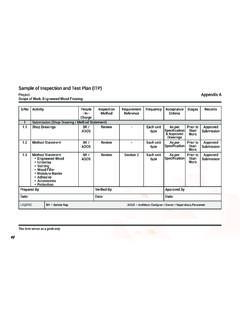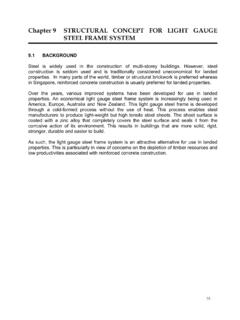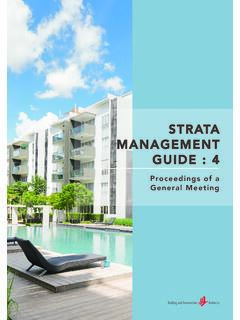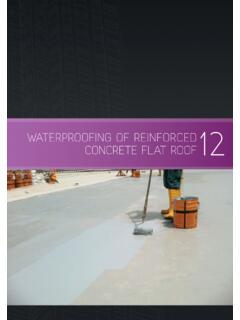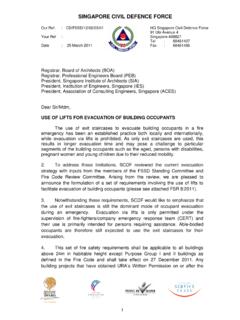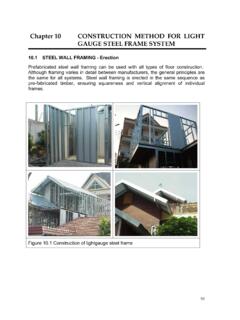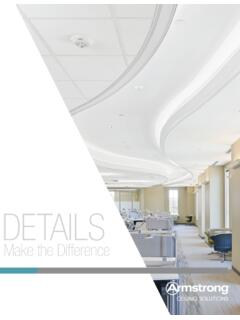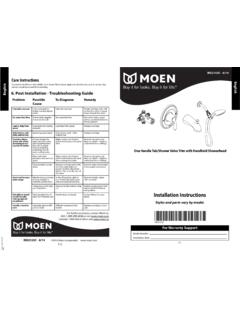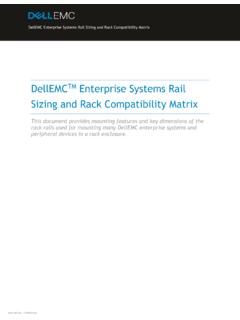Transcription of 6. INSTALLATION
1 25It is essential to identify location of openings, mechanical and electrical (M&E) services, and other fixtures before INSTALLATION of drywall. The setting out of the framing system, openings and additional supports are critical contributors toward the functionality of the drywall. Sequence of board INSTALLATION , proper infill and insulation material INSTALLATION , and treatment material compatibility are also important to achieving quality work. All site work should be carried out in a safe manner to comply with safety Framing WorksFraming works form the structural component of the drywall.
2 It is also critical towards fulfilling its functionality as a wall. Figure highlights the sequence of the framing INSTALLATION process and the recommended good practices to achieve quality Drywall Frame INSTALLATION SequenceWork SequenceGood Practices1. Mark out the starting line To ensure starting line and level as per approved shop drawings. Starting line should be marked on end wall or column, slab soffit and floor slab. Opening locations should be marked Install top track To ensure evenness of slab soffit before installing the top track. Tracks should be fastened to structural elements by using anchor bolt or fastener.
3 Joints in the tracks shall be butt INSTALLATION26 Work SequenceGood Practices3. Install bottom track Floor is to be levelled before installing the bottom track. Tracks should be fastened to structural elements by using anchor bolt or fastener. Joints in the tracks shall be butt Bottom track to incorporate M&E concealed services To ensure all M&E concealed services are within the Install starter stud To ensure verticality of the end wall use a spirit level or laser marker. Gap to be allocated at top track to allow for deflection of top slab. Place studs in direct contact with doors frame jambs, abutting partitions, partition corners/edges, and existing construction elements.
4 To check overall verticality of INSTALLATION 27 Work SequenceGood Practices5. Install intermediate studs Studs to be installed at interval as per approved shop drawings. Intermediate studs must face same direction to allow for adjustment when fixing plasterboard. Do not splice vertical metal stud members. To check overall verticality of Install bracing Horizontal bracing for all stud partitions to be as per manufacturer s recommendation. Provide all braced framing of load bearing steel stud framing as detailed in approved shop drawings. Additional hollow section for bracing and load bearing steel studINSTALLATION OpeningThe most common openings on drywall are for doors.
5 Such openings are usually reinforced by the introduction of box stud to stiffen the opening. Figure illustrates the sequence of opening stiffening and the relevant good practices to achieve quality Framing for OpeningsWork SequenceGood Practices1. Install starter stud Fix all starter studs as per approved Install metal box studs to secure door frame To secure the door frame, form a metal box stud to fix into back of starter 29 Work SequenceGood Install metal bracing above door frame to secure it Metal bracing or door head trimmer must be installed for door Alternative stiffener for door Rectangular hollow section or timber with the same width as the stud to be placed and properly secured as per approved shop drawing and method Additional Supports for M&E Services and Other FixturesAdditional supports in the drywall frame are required for fixtures such as Fan Coil Unit (FCU) and electrical switches.
6 Spacing of vertical studs and/or bracing to be adjusted accordingly to accommodate the size and weight of fixtures. Figure demonstrates some examples of necessary additional supports and the relevant good practices to achieve quality Additional Supports for M&E Services and Other FixturesWork SequenceGood Practices1. Additional support for M&E services Identify location and type of M&E services. Identify penetration for wiring. Metal bracing must be provided for the M&E Install additional bracing for M&E services Identify location of M&E services.
7 Ensure proper planning for wiring to enable provision of opening and bracing for 31 Work SequenceGood Install additional support for FCU Identify location of FCU. Ensure support is sufficient to accommodate FCU. Metal bracing must be done at FCU to withstand the imposed other additional fixtures to be mounted on drywall should be identified early and indicated in all shop drawings as well as method statement for approval. Additional supports should be duly designed and endorsed by the professional Board InstallationThe overall framing INSTALLATION is heavily dependent on board dimension and type of board layout.
8 Figure shows the importance of board dimension affecting framing works and the relevant good practices to achieve quality Importance of Board Dimension and Board Layout Affecting Framing WorksWork SequenceGood Practices1. Typical board sizes Identify and calculate area and layout of board to be installed. Frame spacing to be in accordance to board dimension and Cutting of Boards Use proper tools such as T-square and cutting knife to cut 33 Work SequenceGood Practices2. Sequence of horizontal board INSTALLATION Ensure horizontal board INSTALLATION sequence as per method statement.
9 Install panels in such a manner that panel joints do not align with edge of opening. For multi-layered boards, stagger joints between the layers, as well as on opposite sides of partitions. Tightly butt tapered end board edge joints. For vertical board INSTALLATION , start centre and place smaller boards at sides or vertical board INSTALLATION , start centre and place smaller boards at sides or edgeINSTALLATION 34 Work SequenceGood Securing of board All butt joint screws are to be staggered. Plasterboard screws should be spacedi. <300mm for butt jointsii.
10 <200mm for angles jointsiii. 10 to 16mm from edges and ends of plasterboard sheets Ensure securing process of the board onto the vertical stud does not cause tilting of flange . Application of drywall screws shall begin from centre outwards. Install screws from ends and edges of panels, and on centre along abutting end joints; and, on centre within the field of the panel. Panels shall not fasten directly to the top and bottom runners to allow for top slab deflection movement. Application of drywall screws shall begin from centre fastening of panels to bottom 35 Work SequenceGood Practices3.
